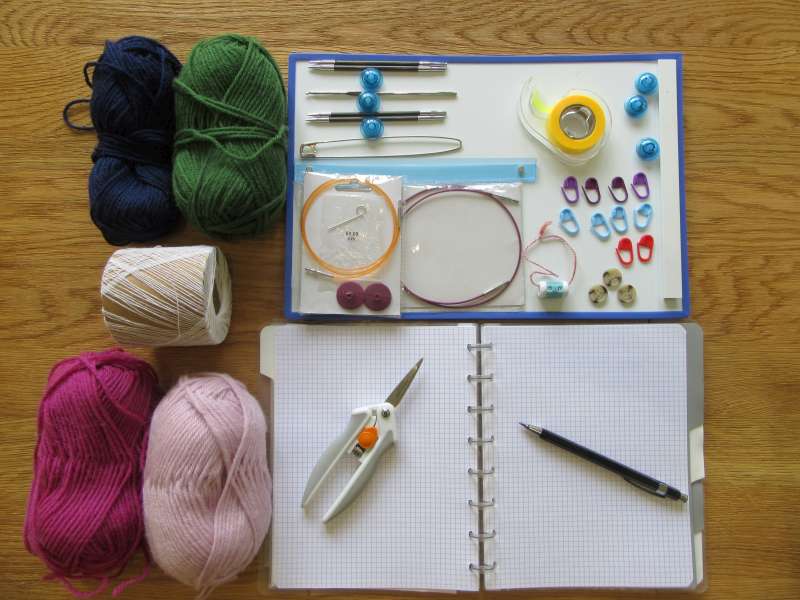By the end of the workshop and completion of the workshop project participants will have the confidence to plan and execute a project using stranded colour work based on a published pattern.
This is an online interactive workshop with interactive group teleconferencing sessions supported by an email discussion group, web pages and downloads.
This workshop is free.
There are no planned dates for the workshop.
Register for the workshop
Please register for this free workshop using the Workshop Application Page.
Workshop contents
The workshop is based around a practical project to make a miniature stranded colour work sleeveless cardigan. During the stages of the project, you will be helped to:
- Cast on in preparation for knitting a stranded project in the round;
- Hold yarn for knitting in two colours using a technique with which you feel comfortable;
- Knit stranded rib (also known as cartridge rib);
- Interpret a variety of styles of chart used for colour work;
- Knit colour work in the round in stocking stitch (using knit stitches only);
- Catch your floats to avoid long loops that might be pulled by fingers;
- Knit colour work “flat” in stocking stitch (using both knit and purl stitches);
- Simple shaping using decreases within a colour work pattern;
- Picking up stitches along the edge of a piece of colour work;
- Preparing and cutting a steek.
Skills you will need before you take part in the workshop
In order to benefit most from the workshop and not hold back other participants, you will need to be able to:
- Cast on and join for knitting in the round, using either double pointed needles or a circular needle;
- If you are using a circular needle, you need to be able to knit an item that is smaller than the length of the needle (by using two circular needles, or by using the magic loop/travelling loop methods);
- Knit and purl;
- Decrease using right-leaning (k2tog) and left-leaning (ssk or sl1 k1 psso) decreases;
- Pick up and knit stitches from the sides and top of a piece of knitting.
Technology
This workshop is delivered remotely, so you will need some technology to help you.
You may join the workshop events either from a computer/laptop that has both a webcam and a microphone, or with a smartphone/tablet. You can find instructions on how to connect on the Using video conference applications page.
You will need an internet connection that downloads fast enough to stream video.
Materials and notions
Yarn
Double knitting wool. 20g in each of four contrasting colours. This should not
be superwash. Choose wool that has good stitch definition. Two colours are
background colours and two are contrast colours. The project will look better if the background colours share a “theme” and the contrast colours share a “theme” (for example the background colours might be mid and light grey, and the contrast colours primary colours), but the most important thing is that you can distinguish easily between the four colours. You can check this by using your phone – look at a monochrome image of the yarns.
Thinner yarn. 4m of 4 ply (or thinner) yarn. The fibre content of this yarn is not
important so long as the yarn is smooth and without a halo. It should contrast with all four of the double knitting yarns.
Needles
Knitting needles. 4mm and 3.5mm needles. For each size you could use either a set of 5 double pointed needles or a circular needle of at least 80cm length (if you use two circular needles to knit in the round, you will need two of each size, but these could be shorter). You will use both needle sizes at the same time, so if you use interchangeable needles bring both sizes already connected to their cables.
Crochet hook. 2.75 mm crochet hook. The size is not critical – you could go up or down a size.
Notions
Stitch markers. You will need at least ten stitch markers. As you will place these between stitches that are already on the needles, it is preferable to use markers that fasten and unfasten (locking type). An alternative is to use the “thinner yarn” as place markers.
Buttons. Three shirt buttons.
Small, sharp scissors. Scissors will be used to cut your steeks.
Embroidery needle. An embroidery needle with eye large enough for double knitting (DK) yarn.
Optional notions.
- Row counter;
- A4 magnetic board, magnets to hold paper in place, and magnetic rule;
- Highlighter tape;
- Stitch holder.
Workshop events
The activities and events associated with this workshop are listed below.
No events are planned at the moment



